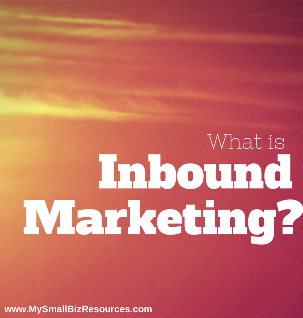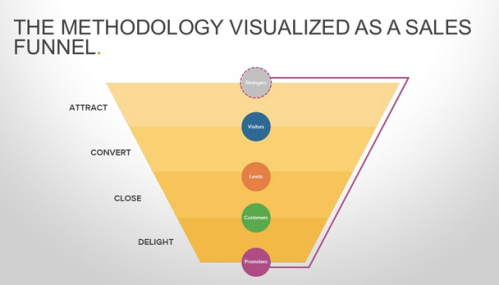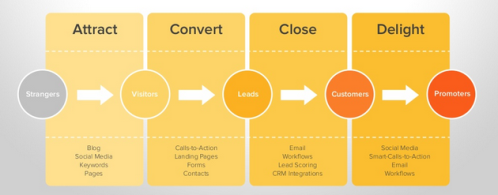 Here are some interesting stats about Inbound Marketing…
Here are some interesting stats about Inbound Marketing…
- According to Search Engine Journal, leads obtained through Inbound Marketing cost 61% less than those obtained through traditional outbound marketing.
- Nearly 60% of Marketers have adopted Inbound Strategies (Source: Hubspot)
- Companies that Blog generate 55% more website visitors, 97% more inbound links and 434% more indexed pages than those that don’t.
So what exactly is ‘Inbound Marketing’? That’s a good question and one that many marketers and business owners are still trying to figure out. Although the term has been around for almost 10 years, it continues to create some confusion.
Is it Search Engine Optimization? Social Media Marketing? Content Marketing?
It actually incorporates all these disciplines and more…
Thankfully, I recently stumbled across – what is perhaps – one of the best explanations I’ve seen of the term ‘Inbound Marketing’. It’s no surprise that this Slideshare presentation was put together by the talented folks over at Hubspot, the real masters when it comes to implementing an Inbound Marketing strategy (I believe the term ‘Inbound Marketing’ was actually coined by their co-founders).
I have embedded a copy of the Slideshare presentation at the bottom of this post; however, let’s take a quick look at some of the key points and fundamental of Inbound Marketing highlighted in the slides.
Inbound Marketing can be defined in 3 ways: As a philosophy, a methodology and a set of tools.
What is Inbound Marketing?
Rather than using more traditional marketing strategies such as buying ads (press, tv, etc), buying email lists or cold calling, Inbound Marketing focuses on creating educational content that pulls people towards your website where they’ll learn more about what you have to offer.
Your business gets found by qualified leads online thanks to the great content on your website pages, blog articles and social media updates, all of these optimized for search and social media.
Once you understand what content pulls your buyers through the sales funnel, you can use that context to personalize your marketing at scale.
The Inbound Marketing Philosophy (Why?)
Consumers buy differently today than they did 10 years ago. Before the internet, buyers were relatively uninformed and their ‘buyer journey’ was basically linear. Marketer’s playbooks were made up of interruption-based techniques such as cold calling and advertising.
Today, things have changed… drastically!
Thanks to the power of the internet, buyers are well prepared and informed. The ‘buyer journey’ starts with a Google search and is more fluid and random. The marketer’s playbook now encompasses providing thought leadership in their chosen market through the use of high quality content.
So why are interruptive advertising and cold calling not as effective as they once were?
Here are a few reasons…
- The media landscape is cluttered with magazines, TV channels and millions of websites for every possible interest.
- Deceptive Advertising: Accustomed to false claims, over-promising, under-delivering and deceit in advertising, consumers are just not ‘buying it’ anymore (excuse the pun), they just don’t trust the advertisements they are being exposed to on a daily basis.
- Technology has empowered the consumer. They now have access to tools and information (VCR’s, Spam software, Do Not Call List, Social Media) which allow them to circumvent these interruptive brands messages and go straight to the information they seek.
Aligning your content to the needs and interests of your customers allows you to earn permission to market to prospects which you can then convert to leads and hopefully into customers. Delighting these new customers inevitably turns them into promoters of your brand.
Inbound Marketing Methodology (How?)
The Inbound Marketing Methodology helps brands attract, convert, close and delight visitors, leads and customers through a variety of channels including: Blogging, social media, search engine optimization (SEO), landing pages, forms and email.
As you can see in the image, the methodology can be visualized as a sales funnel.

So let’s look at each of the steps involved…
- Attract your ideal customer or buyer persona by creating content that’s valuable and easy for them to find. To do this you would use the following tools: Blog, social media, keywords, website pages.
- Convert these new website visitors into leads by gathering their contact information. The best way to do this valuable information is to offer something in return. An example would be a free ebook. The tools needed to convert visitors to leads would be Calls-to-action, landing pages, forms and contacts.
- Close leads into customers through lead nurturing. Once you’ve attracted the right visitors and converted the right leads, you need to turn them into customers. The way to do this is through targeted, automated email nurturing and social media interaction. Email, workflows, lead scoring and CRM’s are all tools that will help you do this.
- Delight your customers and turn them into promoters of your brand. By using context and personalization, you can deliver tailored messages and continue to engage with, delight and (hopefully) upsell your current customer base into happy promoters of your brand and company. Social media, smart-calls-to-action, email and workflows are the tools you would use to delight your customers.
Inbound Marketing Tools (The Playbook)
Each of the steps in the Inbound Marketing methodology requires a set of specific tools. The image below clearly outlines the tools needed as you go through the process of Attracting customers to your site, Converting them into leads, Closing them so that they become customers and, finally, Delighting them so that they become promoters of your brand.

Here’s how the Inbound Marketing methodology and tools work together :
1) Attract (Get traffic): Create useful, high quality blog content, make sure that content is Search Engine Optimized (SEO) and then go ahead and promote the hell out of it using Social Media sites.
2) Convert (Get Leads): Place Calls-to-action throughout your website, blog, social media accounts and email. This will drive visitors to your landing pages with forms.
3) Close (Get Customers): Once you have your leads, send them targeted and automated emails, driving them through your buying cycle. Provide your sales team with lead intelligence for more effective sales calls.
4) Delight (Analyze and optimize): Analyze the success of your marketing campaigns and determine the areas that need optimization and personalization for future success.
Closing thoughts
There’s no doubt that reaching today’s consumer is complicated and challenging. The old methods of bombarding them with advertising and direct messages are no longer as effective and there is a need for a new marketing paradigm… enter Inbound Marketing.
It’s all about …
- Building trust, not skepticism among your propects
- Being loved, not ignored by your customers
- Outsmarting, not outspending your competitors
Here’s the full Slideshare presentation… study it, digest its content and, more importantly, apply its principles to your marketing strategy!
Happy Marketing!